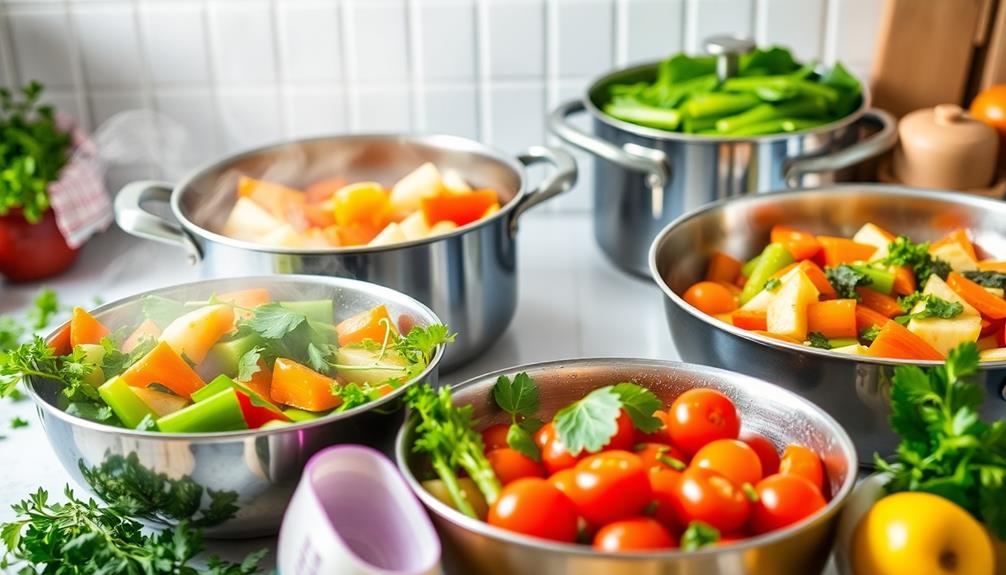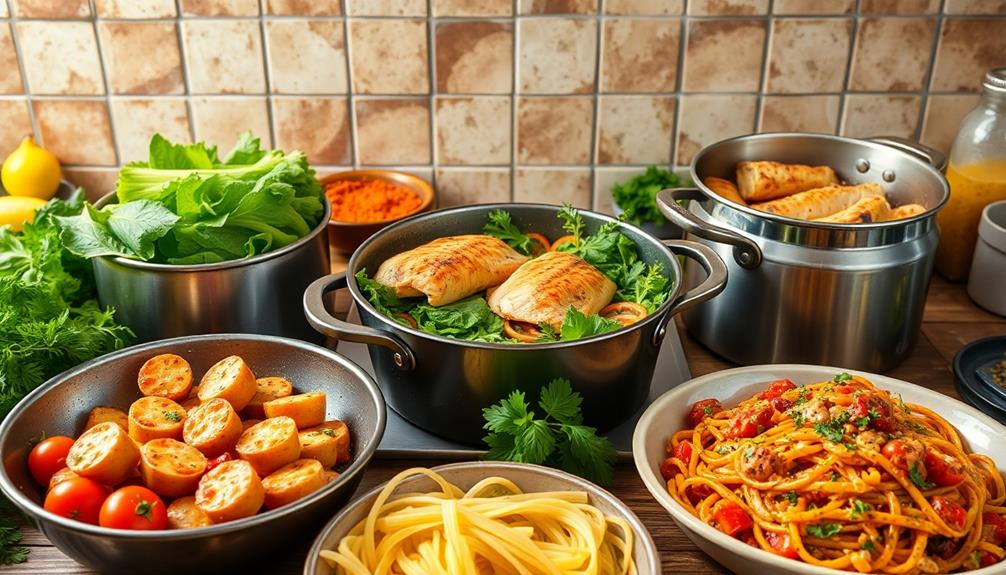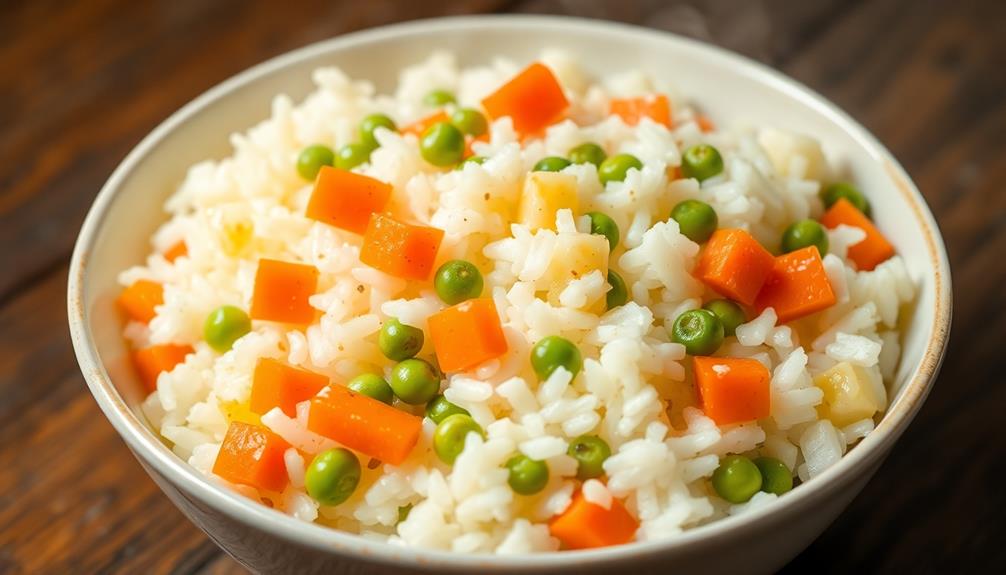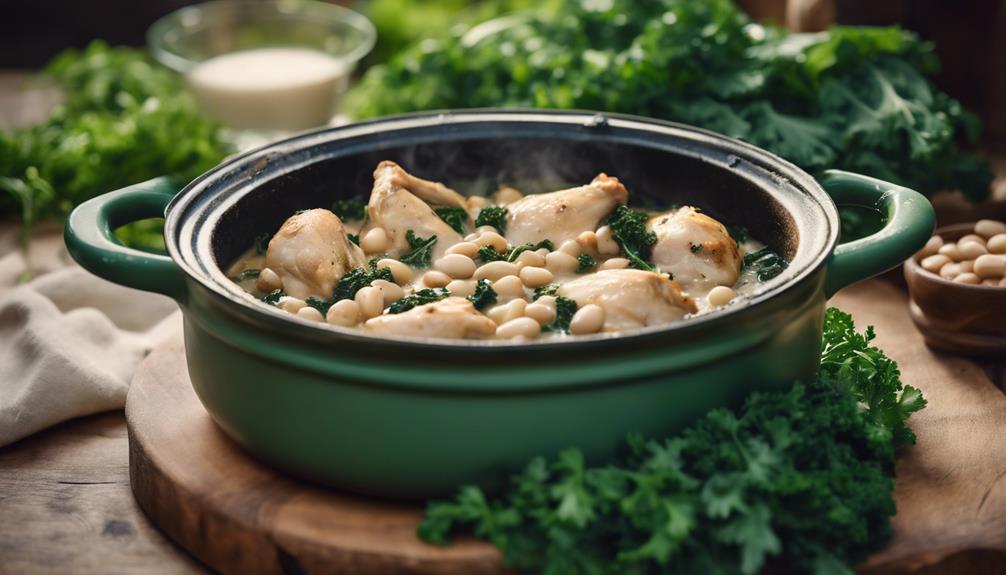Cooking methods greatly impact the nutrient content of your meals. Steaming and microwaving are excellent choices, as they can preserve over 90% of vitamin C. In contrast, boiling can cause significant losses, up to 70% of water-soluble vitamins. While techniques like stir-frying enhance nutrient absorption, deep-frying can increase calories and reduce nutrients. To maximize health benefits, consider using minimal water, shorter cooking times, and the cooking liquid itself to reclaim valuable nutrients. The way you cook can drastically change the nutritional value, and there's much more to explore about optimizing your cooking techniques.
Key Takeaways
- Steaming and microwaving preserve up to 90% of vitamin C, retaining more nutrients than boiling or frying.
- Boiling vegetables can cause 50-70% loss of water-soluble vitamins, particularly vitamin C.
- Stir-frying enhances absorption of fat-soluble vitamins, increasing nutrient availability significantly.
- Consuming cooking liquids can recover 100% of minerals and 70-90% of B vitamins lost during cooking.
- Cooking methods like grilling and baking are healthier for meat, preserving omega-3 fatty acids better than frying.
Nutrient Retention in Cooking Methods

When it comes to nutrient retention in cooking methods, the differences can be striking. For example, steaming is a champion when it comes to preserving vitamin C, maintaining up to 90% of this essential nutrient. In dishes like Nettle and Potato Soup, where fresh ingredients are celebrated, steaming can help retain their nutritional benefits.
On the flip side, boiling can lead to significant nutrient loss, with water-soluble vitamins like vitamin C suffering losses of 50-70%. If you're looking for efficiency, microwaving is also a great choice, as it retains over 90% of vitamin C due to shorter cooking times and minimal water usage.
Stir-frying, on the other hand, improves the bioavailability of fat-soluble vitamins. When you stir-fry carrots, you can enhance beta carotene absorption by 6.5 times compared to eating them raw.
Other methods like grilling and baking generally do well in preserving the nutritional quality of meats and vegetables, but deep-frying can increase calorie content while causing some nutrient loss.
Impact of Water-Based Cooking

Water-based cooking methods, such as boiling, simmering, and poaching, can greatly affect the nutrient content of your food. For instance, boiling vegetables can lead to considerable nutrient loss, with up to 50% of vitamin C leaching into the water. Dishes like Chinese Steamed Egg showcase how steaming can preserve natural flavors and nutrients effectively.
Simmering meat might result in a loss of up to 60% of B vitamins. However, if you consume the cooking liquid, you can retain 100% of minerals and 70-90% of B vitamins.
Steaming stands out as a more effective water-based cooking method for preserving nutrients—maintaining up to 90% of vitamin C due to reduced water contact and gentler cooking processes. Notably, boiling fish is noted to better preserve omega-3 fatty acids compared to other cooking methods, highlighting how your choice of cooking methods can greatly impact nutrient retention.
Microwaving vegetables also proves advantageous, retaining over 90% of vitamin C because it typically involves shorter cooking times and less water than traditional boiling methods.
Techniques for Nutrient Preservation

To maximize nutrient preservation in your meals, employing effective cooking techniques is essential. Opt for cooking methods like steaming and microwaving, which can preserve up to 90% of vitamin C content in vegetables. Additionally, sautéing with minimal oil and avoiding prolonged cooking times can help retain other vital nutrients, such as B vitamins and antioxidants. Incorporating fresh, raw produce alongside cooked dishes is another excellent way to ensure a balanced intake of essential nutrients. Many parents also find value in scheduling **appointments for children at garden** programs, where kids can learn hands-on about the benefits of farm-fresh produce while developing healthier eating habits.
For instance, when cooking dishes like Mushroom Masala, employing steaming can enhance the retention of vitamins while keeping the rich flavors intact. In contrast, boiling can lead to significant nutrient loss, with 50-70% of vitamin C disappearing.
To protect water-soluble vitamins, use minimal water during cooking and try to keep cooking times shorter; sautéing vegetables can maintain more vitamins than prolonged boiling or roasting.
Stir-frying is another great technique, as it enhances the absorption of fat-soluble vitamins. For example, studies show you can absorb 6.5 times more beta carotene from stir-fried carrots than from raw.
Lower temperatures also play a vital role in nutrient preservation. If you do boil vegetables, consider using the cooking liquids, like broth, to reclaim valuable minerals and 70-90% of B vitamins.
Cooking Meat and Fish Effectively

Cooking meat and fish effectively requires attention to both methods and temperatures to guarantee safety and nutrient retention. Choosing the right cooking methods can greatly impact the nutrient content of your meals.
Steaming and poaching are great options for cooking fish, as they preserve omega-3 fatty acids and moisture better than frying, which can lead to vitamin losses and texture issues. For example, dishes like Hiyashi Chuka (Cold Ramen) showcase how the right preparation can enhance flavor while maintaining nutritional value.
When it comes to meat, grilling, baking, or steaming are healthier choices compared to frying, which can add harmful fats and compounds. It's essential to adhere to proper cooking temperatures to eliminate harmful bacteria. For instance, ground meats must reach an internal temperature of 160°F for safety.
To further enhance health benefits, avoid charring or overcooking your meat, as these practices can create harmful compounds. Using marinades can also help retain nutrients while adding flavor.
Raw vs. Cooked Nutritional Benefits

When contemplating the nutritional benefits of raw versus cooked foods, you'll find that both preparation methods offer unique advantages. For example, certain traditional Brazilian dishes like Caldeirada showcase the nutritional power of seafood, which is enhanced through cooking methods that maximize nutrient absorption.
Raw vegetables maintain certain enzymes and vitamins that cooking can destroy, providing a fresh source of nutrients. However, cooking methods can greatly enhance the bioavailability of other nutrients. For instance, the absorption of beta-carotene from cooked carrots increases by 6.5 times compared to when they're raw.
While boiling spinach can lead to a loss of vitamin C—up to 57.85%—microwaving retains over 90% of this crucial nutrient. Cooking tomatoes boosts lycopene levels by 80% when sautéed in olive oil, making them more accessible.
Additionally, ingredients like cassava, commonly used in Brazilian cuisine, can offer different health benefits depending on whether they're consumed raw or cooked, highlighting the importance of cooking methods in preserving and enhancing nutrients regional culinary traditions.
It's essential to evaluate the nutrient content and how heat affects it. Cooking can reduce antinutrients, enhancing absorption of beneficial compounds, while raw foods can be rich in certain vitamins.
Balancing raw and cooked vegetables in your diet optimizes nutritional value, allowing you to maximize the benefits of both preparation methods. By understanding these differences, you can make informed choices that contribute to your overall health and well-being.
Frequently Asked Questions
How Do Cooking Methods Affect Nutritional Value?
Cooking methods really impact nutritional value. When you boil, you might lose vitamins, while steaming or microwaving preserves most nutrients. Quick methods like stir-frying enhance nutrients, making your meals both tasty and healthy.
Which Cooking Method Destroys Nutrients?
Certain cooking methods, like boiling and prolonged roasting, destroy nutrients. You'll lose significant amounts of water-soluble vitamins, especially when you overcook. To preserve nutrients, consider quicker methods like microwaving or stir-frying for shorter durations.
Which Cooking Methods Could Lose Nutrients?
Oh, the joys of boiling! You're practically flushing nutrients down the drain. Frying? It's a one-way ticket to Fatville. Simmering? Say goodbye to B vitamins. Stick to microwaving for a nutrient-saving miracle, if you're lucky!
How Does Cooking Affect the Vitamin Content of Food?
Cooking affects vitamin content by altering nutrient retention. You'll find that methods like steaming and microwaving preserve more vitamins, while boiling can lead to significant losses. Choosing your cooking techniques wisely can maximize nutrient intake.
Conclusion
To sum up, understanding how cooking methods affect nutrient content is essential for maximizing your meals' health benefits. Just like a sponge soaks up water, different techniques can either retain or drain nutrients from your food. By opting for gentle cooking methods and being mindful of water usage, you can keep more vitamins and minerals intact. Remember, a little knowledge goes a long way in ensuring your meals are as nutritious as they are delicious!









